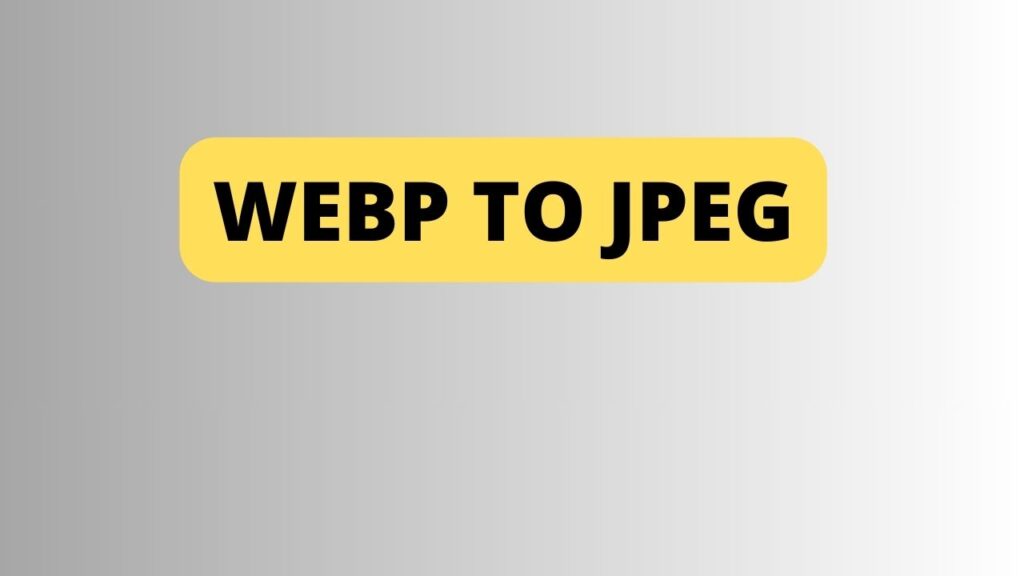Introduction
In the digital landscape Webp to Jpeg , image formats play a crucial role in content delivery. Understanding the nuances between formats like WebP and JPEG is vital for efficient web usage.
WebP to JPEG Conversion Methods
WebP to JPEG Conversion Explained
The Significance of WebP Images
Understanding JPEG: A Widely Compatible Format
Comparison: WebP vs. JPEG
Online Tools for Quick Conversion
Efficient Tools and Techniques
Method 1: Using Online Converters
Method 2: Utilizing Image Editors
Method 3: Command Line Conversion
Ensuring Image Quality
Retaining Image Resolution
Color Space Considerations
Compression Settings for Optimal Quality
Steps for Seamless Conversion
Step 1: Selecting the Right Converter
Step 2: Uploading WebP Images
Step 3: Choosing Output Settings
Step 4: Executing the Conversion
Step 5: Downloading JPEG Images
Advantages of JPEG Conversion
Compatibility Across Devices
Reduced File Size Without Compromising Quality
Widespread Support in Web Development
Understanding WebP Format
WebP, developed by Google, revolutionizes image compression by providing both lossy and lossless compression for web images. Its smaller file size and high quality make it a preferred choice for web developers.

Benefits of WebP
WebP Features
The features of WebP, including alpha transparency support and animation capabilities, enhance its appeal for web usage. These features contribute to faster load times and a more engaging user experience.
Advantages of JPEG
While WebP offers significant advantages, JPEG remains a widely accepted image format for its compatibility across various platforms and its established optimization techniques.
Comparison: WebP vs. JPEG
Delving deeper into the differences between WebP and JPEG formats can aid in making informed decisions about image format selection based on specific needs.
Converting WebP to JPEG
Online Conversion Tools
Several online tools simplify the conversion process, allowing users to effortlessly convert WebP images to JPEG without compromising quality.
Manual Conversion Methods
For those preferring manual processes, step-by-step guides can facilitate the transformation of WebP images into the JPEG format using various software and tools.
Compatibility Issues
Despite its advantages, WebP’s compatibility with different browsers and platforms might present challenges, necessitating considerations for broader accessibility.
Image Quality
Understanding the nuances of image quality and compression techniques ensures that the converted JPEG images maintain the desired visual standards.
SEO Impact
The impact of image formats on SEO highlights the importance of optimizing images for search engines. Choosing the right format and employing optimization techniques significantly influences web ranking.
Best Practices
Optimizing Image Formats
Implementing best practices for image optimization involves a combination of format selection, compression techniques, and adherence to web standards for enhanced user experience.
Common FAQs
What is WebP format? Explore the foundational aspects of the WebP format and its significance in web development.
How to convert WebP to JPEG? Discover easy-to-follow methods and tools for seamless WebP to JPEG conversion.
Are there any quality differences? Understand the potential differences in image quality between WebP and JPEG formats.
Can WebP images be optimized for SEO? Learn strategies to optimize WebP images for improved search engine visibility.
Which browsers support WebP? Explore the browser compatibility of WebP images for wider accessibility.
What are the advantages of JPEG? Understand the enduring advantages and applications of the JPEG format in web contexts.
Conclusion
Converting images from WebP to JPEG presents a seamless solution for compatibility and size optimization. With an array of tools and techniques available, preserving image quality while transforming formats is achievable. Explore these methods, weigh the advantages, and embark on a journey of efficient image transformation.
Key Takeaways
- WebP offers efficient compression and features but may face compatibility challenges.
- Conversion methods and optimization techniques play pivotal roles in ensuring image quality and SEO impact.
- JPEG remains a versatile format with established optimization practices for widespread compatibility.
